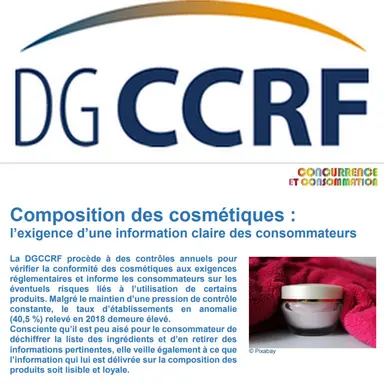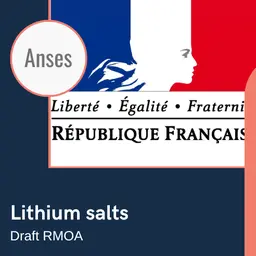
The French DGCCRF carries out annual inspections to check the compliance of cosmetics with regulatory requirements and informs consumers of possible risks associated with the use of certain products. It has just published the results of its controls for 2018. With one observation: despite the maintenance of constant control pressure, the rate of establishments in anomaly (40.5%) remains high.
Aware that it is not easy for consumers to decipher the list of ingredients and to obtain relevant information, the DGCCRF also ensures that the information provided to them on the composition of products is readable and fair.
The use of non-compliant cosmetic products may present a health risk. In 2018, 88 products were alerted or reported due to a chemical or microbiological risk, two reports of cosmetovigilance (health professionals or users can report to health authorities on the site signalement-sante.gouv.fr any incident whose adverse reactions are related to health products) have been transmitted to the ANSM and 20 RAPEX notifications have been made (12 by DGCCRF and 8 from other European authorities).
Skin creams, emulsions, gels and oils (including skin lightening products, which often contain illegal substances such as hydroquinone and glucocorticoid), skin care products and bath products are among the items most affected by these alerts.
As the market surveillance authority for cosmetics in conjunction with the ANSM, the DGCCRF monitors the loyalty and safety of products marketed in France through its investigations. As such, it carries out annual controls on cosmetic products manufactured in France and in the countries of the European Union or imported from a third country. These controls are intended to verify the compliance of cosmetics with European and national regulations: labelling and composition of products, claims and evaluation and information obligations imposed on professionals (product information file, notification on the CPNP portal, good manufacturing practices).
The aim is to guarantee the health and safety of consumers but also to ensure the proper functioning of the cosmetics market, as this sector of activity is essential for the French economy.
| A few points of reference |
|---|
|
• France is the world’s leading producer of perfumes and cosmetics and enjoys an excellent international reputation in this field. • The French cosmetics industry (perfumes, shampoos, shower gels, toothpastes, hair gel or mousse, deodorants, baby lotions, make-up, sun creams…) generated a turnover of €10 billion in 2017. This sector had 650 establishments in 2016. • Online sales have increased sharply in recent years. All the major beauty brands now have their own commercial websites. In 2016, online purchases represented €147 million, an increase of 21% compared to the previous year. |
Incomplete product traceability and insufficient information lead to risks for the consumer
In 2018, three areas of investigation were given priority:
• The search for substances in nanometric form, in particular in sunscreen products: these are subject to conditions of use and must be labelled[nano] on the packaging
• Cosmetics sold in bazaars or by wholesalers: these operators are likely to distribute cosmetics placed on the market several months or years before, the minimum durability date may have been exceeded, transport and storage conditions may have been altered and regulatory changes requiring products containing newly banned substances to be withdrawn from the market may not have been taken into account
• The display of the list of ingredients on distance selling sites: websites often present a list of ingredients that do not correspond to the product marketed
Labelling of nanomaterials in solar cosmetics
Nanomaterials are materials whose size or structure has at least one dimension between 1 and 100 nanometers. This size gives them particular physical, chemical or biological properties.
Sunscreen products contain organic or mineral filters to protect users from the harmful effects of the sun. The authorised sunscreens are subject to a restrictive list in Regulation (EC) No.1223/2009 on cosmetic products.
If the sunscreen product contains titanium dioxide or zinc oxide (in nanoparticulate form), the words[nano] must be indicated on the label and in the list of ingredients when declared on the CPNP portal.
Out of 39 products analysed in 2018, 19 had at least one anomaly. The main shortcoming noted: the presence of these ingredients without the mention [nano].
Shortcomings in the distribution circuit of products among manufacturers or importers
The placing on the market of a cosmetic product implies the mandatory designation of a Responsible Person (the manufacturer or importer) who guarantees, for each cosmetic product marketed, its conformity with European regulatory obligations. To this end, a Product Information File (PIF) must be prepared by this professional. These elements, made available to the control authority, must contain all the characteristics of the product (as regards its composition) and the safety assessment. The inspectors noted recurrent difficulties in accessing PIFs and serious anomalies that could affect consumer health: lack of toxicological information for certain raw materials, traces of undocumented prohibited substances and product safety assessed by an unqualified professional.
The second obligation imposed by the regulations on the Responsible Person consists, for each product marketed in the European Union, in making a declaration on the CPNP portal (European Cosmetic Product Notification Portal) before it is placed on the market. This communication shall contain information on the product, the Member State in which it will be marketed, the contact details of the Responsible Person and the person to contact if necessary. The inspectors noted that nearly 9% of professionals do not notify their products on the portal and 10% do so in an approximate way.
The presence of expired products and incomplete labelling at distributors, wholesalers and retailers
Some of these operators do not apply the obligations imposed on them. Several anomalies were identified: products containing prohibited substances (isobutylparaben, methylisothiazolinone, methylchloroisothiazolinone, etc.), labelling non-compliance, lack of traceability and non-compliance with the French language on imported products.
Non-compliant information on websites
A total of 349 websites were checked for the display of the ingredient list. The list may be in text or image format, with a photograph from the INCI (International Nomenclature of Cosmetic Ingredients) list on the packaging or container. An anomaly rate of 29% was found. In addition to the failure to display the list of ingredients or incorrect lists, misleading claims, incomplete conditions of sale, in particular on the right of withdrawal and the presence of unfair terms, have been identified.
A misleading valuation of the properties of cosmetic products in order to better sell the product
During the investigation, the persistence of therapeutic claims referring to the treatment of diseases or pharmacological actions was noted, in particular on products based on essential oils or plants.
Other allegations, which constitute misleading commercial practices, were also found:
• “Free from [substance] while the formula contains it
•”Hypoallergenic” or “Free from endocrine disruptors”, claims insufficiently substantiated or unverifiable
• “Not tested on animals”: on this subject, the DGCCRF reminds on its website that animal testing on cosmetic products is prohibited by European regulations with rare exceptions
• Claims referring to a particular or French origin (Made in France) without justification
• “With…”, “Contains…”, “Enriched…” while the finished product contains a minute amount of the claimed substance or ingredient
The marketing of a cosmetic product is strictly regulated by European regulations. However, recurring and sometimes serious anomalies, such as labelling, product documentation (information package) and misleading claims, were identified during this investigation.
In response to this observation and the emergence of diversified marketing methods (platforms, social networks), the DGCCRF will maintain increased vigilance in this sector to ensure consumer safety.
2018 results of the DGCCRF survey
1,836 establishments visited and nearly 700 samples analysed by the Joint Laboratory Service (laboratory shared by DGCCRF and Customs) in Oullins.
Anomaly rate: 40.5% of the establishments visited.
About 1/3 of the websites audited had at least one anomaly.
The follow-up actions
• 503 warnings for minor anomalies
• 216 injunctions for labelling defects, absence or incompleteness of the DIP and misleading claims
• 73 reports for the presence of prohibited substances, absence of allergens in the list of ingredients, absence of PIDs and misleading claims
• Prefectoral decrees ordering the withdrawal from the market or recall of products containing prohibited substances
• Product seizures made for skin bleaching products containing prohibited substances (hydroquinone and glucocorticoids)
It should be noted that a company with several hundred million euros in annual turnover and multiple infringements in 2018 was the subject of a deception report, an injunction to bring product labelling into conformity and a warning for less serious breaches.
Source
• Composition des cosmétiques : l’exigence d’une information claire des consommateurs, DGCCRF, 15 October 2019













